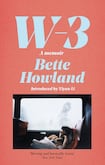
“I should explain right away that I didn’t belong here,” Bette Howland states early on in her compelling and lucid memoir, before adding: “But that goes without saying, no one belonged here.”
“Here” is W-3, the psychiatric ward in a Chicago teaching hospital, where Howland found herself admitted for treatment after an attempt to take her own life. Her memoir, clear-eyed, with an anthropological, sociological distance, is a brilliant attempt to document life on the ward with clinical detachment.
Howland (1937-2017) was the author of several books of fiction as well as this memoir, but stopped publishing in the 1980s after the pressure of receiving a MacArthur Fellowship stifled her. First published in the US in 1974. W-3 is now published for the first time on this side of the Atlantic, with an insightful introduction by Yiyun Li. The book, and Howland’s writing on mental distress and its consequent treatment through hospitalisation, is a wonder.
Her prose is direct, unadorned, understated. Despite the horrors she endures she does not appeal for the reader’s sympathy, but rather seeks to be understood, to have her voice heard, and to have her vision of her story recounted and expressed, a story that otherwise would be put down for her by the doctors, psychiatrists, externs and others she meets along the way: “I would like to put this in a recognizable form,” she writes of her experiences; and goes on to do so forthrightly, and without a trace of self- pity.
Howland captures perfectly one of the existential contradictions of life on a psychiatric ward: how the sufferer is painfully alone and isolated in her being, while at the same time constantly surrounded by others, with the total lack of a private life that entails. For it is a sign of wellness to be left alone, individual,
and she is not deemed well enough to be permitted, to be trusted, to be so.
Forced to endure, to let time pass, on W-3, awaiting discharge, Howland has little option but to observe and offer impressions of her fellow “inmates”. This she does in minute detail, meticulously documenting the world she now finds herself in, and its denizens. In doing so, in recounting the dilemmas of all the other patients she meets on the ward, in seeking to understand them, their plights, their personalities, their illnesses and their treatments, we get insights into Howland and her own state of mind.
By observing others, Howland allows herself to look outwards, refrain from being overly ruminative, self-analytical or self-absorbed. At times, inevitably, this clinical detachment is impossible; and sometimes facing the reality of her situation is unavoidable. A bungled parting from her children leads her to express a rare moment of self-reproach: “It was a terrible thing I had done to them. And I felt like a ghost.”
All the while, Howland captures the life of a hospital psychiatric wing perfectly, with its monotony, boredom and routines, medications and their effects, endless meetings and therapeutic sessions, sleeplessness, the coveted day-passes and privileges, the awful food, the occupational therapy no one wants to do, the acts of violence and self-harm, the dreaded desultory recreational activities, the rudimentary treatment and, of course, the inevitable institutionalisation.
The language used at times reflects the period in which it was written, its directness giving little leeway to contemporary sensitivities; Howland can sound harsh at times, judgmental in her scrutiny of others. Nonetheless, she retains the harshest tone for herself when she does allow herself brief introspection:
“I suddenly saw myself too … loathing and loathsome, thickened, confused, same as all the rest. And none of us knowing what we were doing here, why we belonged, how we had come to this.”
This account of mental distress and hospitalisation is never depressing, thanks to the compelling voice, full of wry, cool humour and clinical detachment that allows us to see not only the pain but also the absurdities of life on a psychiatric ward. This is Howland’s gift, to be able to be part of this life, and yet outside sufficiently to document it so compellingly.
Here, on W-3, patients are encouraged to tell their clinical histories at team meetings, and there is a promise of redemption in this. In telling one’s story, Howland asserts: “ach retelling, each repetition, hastened the time you would get tired of it, bored with it, done with it – let it go, drop it forever – and could soar away and be free.”
W-3: A Memoir, compelling, vivid, enlightening, an essential reissue, could ultimately be seen as Bette Howland’s own attempt to “soar away and be free” through the writing of her own story.
Arnold Thomas Fanning is author of Mind on Fire, shortlisted for the Wellcome Book Prize













